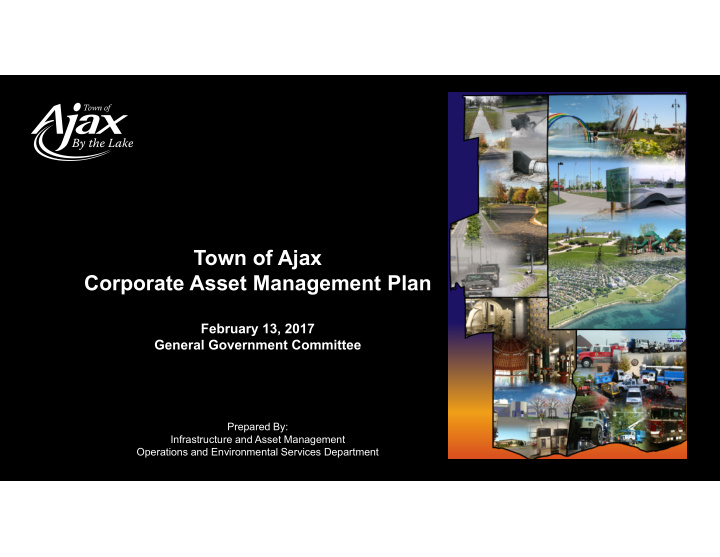



Town of Ajax Corporate Asset Management Plan February 13, 2017 General Government Committee Prepared By: Infrastructure and Asset Management Operations and Environmental Services Department
Current Practices • Staff have been managing the rehabilitation and replacement of assets based on condition for several years • Staff use a range of observations and testing to evaluate asset performance • Staff utilize preventative maintenance processes to extend the life of assets
What is asset management? • Asset Management is a systematic process which allows for the maintenance, upgrading and operation of our physical assets in a cost effective manner.
Why do we need asset management? • Existing infrastructure is ageing • Comply with Infrastructure for Jobs and Prosperity Act, 2015 • Forthcoming regulation under the Act and what will be required by municipalities • Higher standards for health & safety • Environmental protection concerns • Climate change • To inform funding strategies
How was the plan developed? • The Town’s Corporate Asset Management Plan was developed internally by staff without the assistance of consultants • Inventories and condition ratings were applied to each asset category • Age was used for some asset • A standardized rating system was utilized to assess asset condition based on five grades assigned across four factors: deterioration; performance; maintenance costs; and, age.
What are the benefits of asset management? • Reduces life cycle costs through preventative maintenance • Allows for better decisions regarding resource allocation • Provides better & consistent budget forecasting • Reduces risk to municipality • Leads to more efficient data management
What are the essential components of the plan? Asset Value Condition Ratings Preventative Maintenance Sustainability Risk Assessment Integration with Financial Plans
Standardized Rating System A = Very Good Fit for the future B = Good Adequate for now C = Fair Requires attention D = Poor At risk of affecting service E = Very Poor Unsatisfactory for sustained service
State of the Infrastructure 67.8% of the Town’s assets are in “very good to good” condition; 22.3% of the Town’s assets are in “fair” condition; 6.7% of the Town’s assets are in “poor” condition; Poor $80.39 3.3% of the Town’s assets are in “very poor” condition Very Poor 6.7% Fair $39.53 $268.56 3.3% 22.3% Good Very Good $407.75 $409.80 33.8% 34.0% OVERALL ASSET CONDITION RATING ($ MILLIONS)
Age based assets include: • Boulevard Trees • Playgrounds • Sidewalks • Storm Sewer System • Over-time these assets will move to be condition based which will improve the asset ratings for these assets.
Condition Assessments Conducted on a cyclical basis as determined by the assets service life and risk associated with the asset Frequency of Condition Assessment Asset Assessment Conducted by Roads 1/3 Roads annually Consultant Bridges Every 2 years Consultant Culverts over 1.4m Every 2 years Consultant Sidewalks Annually Staff Regulatory Signs Annually Staff Streetlight Luminaires Twice annually Staff Streetlight Poles Every 5 Years Consultant Stormwater Ponds Twice annually Staff Playgrounds Annually Staff Recreational Trails Annually Staff Vehicles Seasonally Staff Regular inspections occur more frequently throughout the year
Risk Assessment Acceptable risk tolerance for each asset must be part of the strategy Condition rating used in the prediction of failure and consequences of failure Risk Factors include: financial, environmental, regulatory/legal, public health and safety
Integration with Financial Sustainability Plan • An Asset Management Plan must be integrated with long term financial planning and capital forecasting in order to meet its objectives • To support the Asset Management Plan staff will update the Financial Sustainability Plan in 2017-2018 • The review of the FSP will support the asset management plan over the long term
What is the current funding gap? Category Average Annual Average Actual Estimated Investment Infrastructure Annual Required (1) Rehabilitation Funding (Gap) / Investment (2) Surplus Transportation $ 8,600,000 $ 8,400,000 $ ( 200,000) Stormwater Management 2,900,000 600,000 ( 2,300,000) Outdoor Active Recreation 1,800,000 1,200,000 ( 600,000) Facilities 1,900,000 2,000,000 100,000 Fleet 2,200,000 2,200,000 - Information Technology 200,000 300,000 100,000 Forestry 1,600,000 900,000 ( 700,000) Annual Funding Shortfall $ (3,600,000)
How do we bridge the gap? • The Town will continue reserve contributions in accordance with the policies of the Financial Sustainability Plan • Continue to fund current replacements and rehabilitation projects from established reserves as set out in the Capital Budget and Long Range Capital Forecast • Future updates of the asset management plan will establish the financial investments required for sustainable asset management.
Conclusion • 90.1% of assets contained in the Ajax AM Plan are in Fair to Very Good condition which would be expected for a relatively young municipality such as Ajax • Staff will continue to update condition ratings of assets • All municipal assets will form part of the Ajax AM Plan over the next few years • As the Ajax AM Plan evolves, so too will the alignment between the Asset Management Plan and the Town’s operating budget, long-range capital forecast and Financial Sustainability Plan
Conclusion con’t The new Asset Management group will continue to employ the effective asset management processes that are already in place. Prioritize investments using this simple method: “Do the right thing to the right asset at the right time”
Questions?
Recommend
More recommend